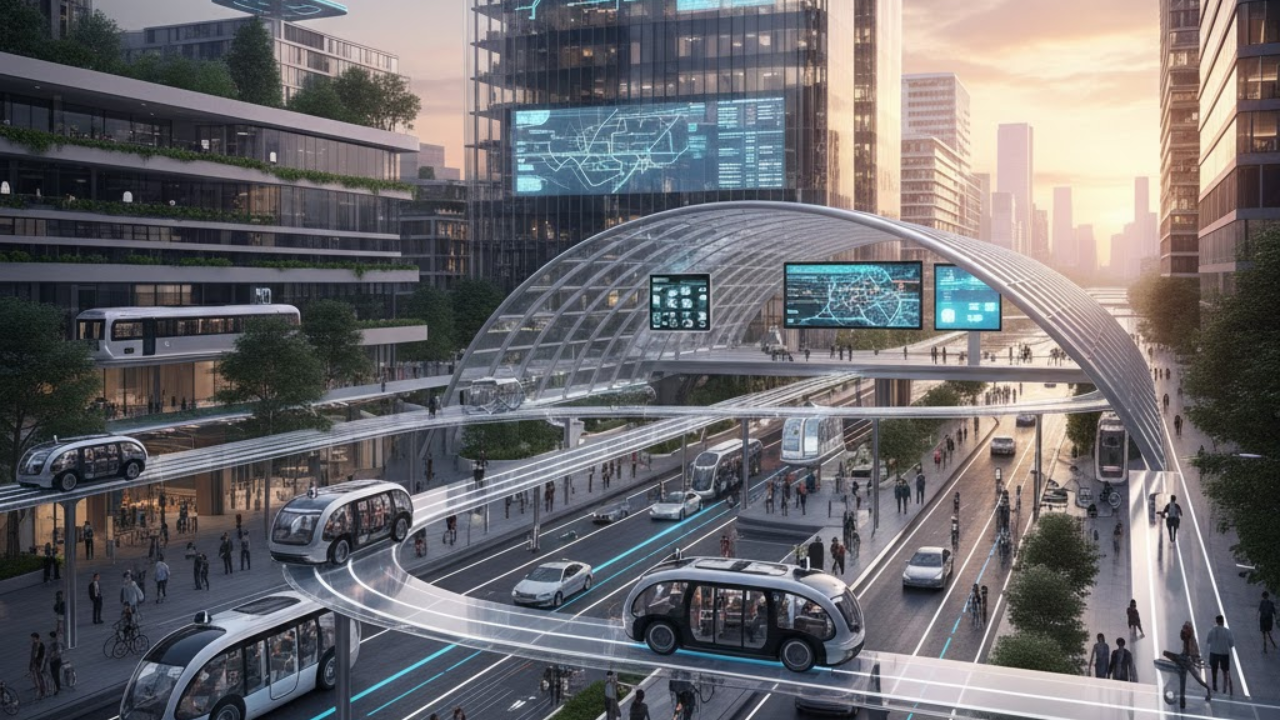
Post by : Meena Rani
Cities around the world are facing an undeniable challenge — how to move millions of people safely, sustainably, and efficiently. Congestion, pollution, and overreliance on private cars have made traditional urban mobility models obsolete.
The solution emerging from this crisis is a blend of autonomous mobility-on-demand (AMoD) and multimodal public transit — a smart, connected transport network where autonomous shuttles, buses, trains, and micro-mobility services operate as one seamless ecosystem.
This integration promises not just convenience, but transformation — the birth of cities designed around mobility intelligence, not traffic chaos.
Autonomous Mobility-on-Demand refers to fleets of self-driving vehicles — shuttles, pods, or cars — that passengers can summon via an app to travel short to medium distances. Unlike fixed routes or schedules, these vehicles dynamically adjust based on demand, reducing idle time and optimizing routes through real-time data.
The real revolution begins when AMoD connects with multimodal transit systems — trains, trams, metros, and buses — creating a continuous, frictionless flow between private and public mobility. Instead of competing, these modes cooperate to deliver end-to-end journeys that are faster, cleaner, and more affordable.
Imagine leaving your apartment, summoning a self-driving shuttle that arrives in minutes, and being dropped directly at a nearby metro station — all coordinated by one unified mobility app. Your ticket covers both rides, your carbon footprint is tracked, and delays are automatically re-routed in real time.
This is the future of multimodal integration — a system where autonomous technology enhances, not replaces, public transport. It makes cities more inclusive by bridging the “first and last mile” gap — the distance between homes, workplaces, and major transit lines that often deters people from using public systems.
At the core of AMoD–transit integration lies data orchestration. Advanced algorithms and AI-driven models analyze city traffic, user demand, and weather patterns to coordinate vehicles and routes dynamically.
Here’s how it functions:
Demand Prediction: AI forecasts ride requests based on time, events, and local trends.
Fleet Coordination: Autonomous shuttles are deployed precisely where and when needed.
Transit Synchronization: Real-time data links with metro and bus schedules to minimize waiting time.
Unified Ticketing: Passengers use a single app for all services — from bike to train to robotaxi.
Dynamic Optimization: The network learns continuously, reducing congestion and travel time citywide.
This system is not futuristic anymore — pilot projects in Singapore, Dubai, Helsinki, and California are already proving its potential.
The integration of AMoD with multimodal systems is about more than efficiency — it’s about sustainability and equity.
Reduced Emissions: Shared autonomous fleets cut down private car use and lower CO₂ levels.
Accessible Transit: Elderly, disabled, and low-income commuters benefit from on-demand, door-to-door service.
Smarter Land Use: Fewer private vehicles mean fewer parking lots and more green spaces.
Cleaner Energy: Many AMoD systems use electric vehicles powered by renewable energy grids.
Together, these changes turn urban transport into a public good rather than a private luxury.
AI sits at the heart of this revolution. It processes vast streams of data from GPS, sensors, and city infrastructure to predict demand, prevent traffic bottlenecks, and optimize fleet performance.
Machine learning enables vehicles to communicate with one another and with city systems, ensuring safe intersections, smooth merges, and efficient use of road space. Over time, the AI becomes smarter — adjusting service density based on commuter behavior and even identifying underserved neighborhoods.
This is mobility that learns, adapts, and evolves — much like a living organism within the city.
As with every innovation, the road to integration isn’t without obstacles. Cities face hurdles in:
Regulation and Liability: Establishing laws for autonomous fleet safety and insurance.
Infrastructure: Upgrading roads and digital networks to support connected vehicles.
Public Trust: Convincing people to trust self-driving technology.
Data Privacy: Ensuring personal travel data is secure and ethically used.
These challenges require close collaboration between governments, private tech firms, and citizens. Only through transparent partnerships can cities realize the true potential of autonomous urban ecosystems.
Several global testbeds are already demonstrating how AMoD complements public transit:
Singapore’s Smart Mobility 2030 integrates autonomous shuttles with MRT stations.
Helsinki’s Kutsuplus Project pioneered AI-based demand prediction for shared transit.
California’s GoMentum Station tests self-driving buses in collaboration with BART metro systems.
Dubai’s RTA Vision 2030 targets 25% of all trips to be autonomous by the end of the decade.
These pilots are proving that automation doesn’t replace human design — it amplifies urban intelligence.
The ultimate goal of integrating AMoD and multimodal transit is to make a city move with rhythm — like an orchestra where every vehicle, signal, and passenger operates in harmony.
No missed connections, no long waits, no unnecessary emissions — just a smooth, coordinated flow of movement. This future isn’t just about transport; it’s about designing cities that breathe, think, and move together.
Disclaimer: This article is for informational and educational purposes only. The integration of autonomous vehicles with public transport requires ongoing research, safety validation, and regulatory oversight before full-scale deployment.
urban mobility, AMoD, multimodal transit, autonomous shuttles, smart cities 2025, intelligent transport, sustainable mobility, AI transportation, connected infrastructure, public transit innovation










Advances in Aerospace Technology and Commercial Aviation Recovery
Insights into breakthrough aerospace technologies and commercial aviation’s recovery amid 2025 chall

Defense Modernization and Strategic Spending Trends
Explore key trends in global defense modernization and strategic military spending shaping 2025 secu

Tens of Thousands Protest in Serbia on Anniversary of Deadly Roof Collapse
Tens of thousands in Novi Sad mark a year since a deadly station roof collapse that killed 16, prote

Canada PM Carney Apologizes to Trump Over Controversial Reagan Anti-Tariff Ad
Canadian PM Mark Carney apologized to President Trump over an Ontario anti-tariff ad quoting Reagan,

The ad that stirred a hornets nest, and made Canadian PM Carney say sorry to Trump
Canadian PM Mark Carney apologizes to US President Trump after a tariff-related ad causes diplomatic

Bengaluru-Mumbai Superfast Train Approved After 30-Year Wait
Railways approves new superfast train connecting Bengaluru and Mumbai, ending a 30-year demand, easi